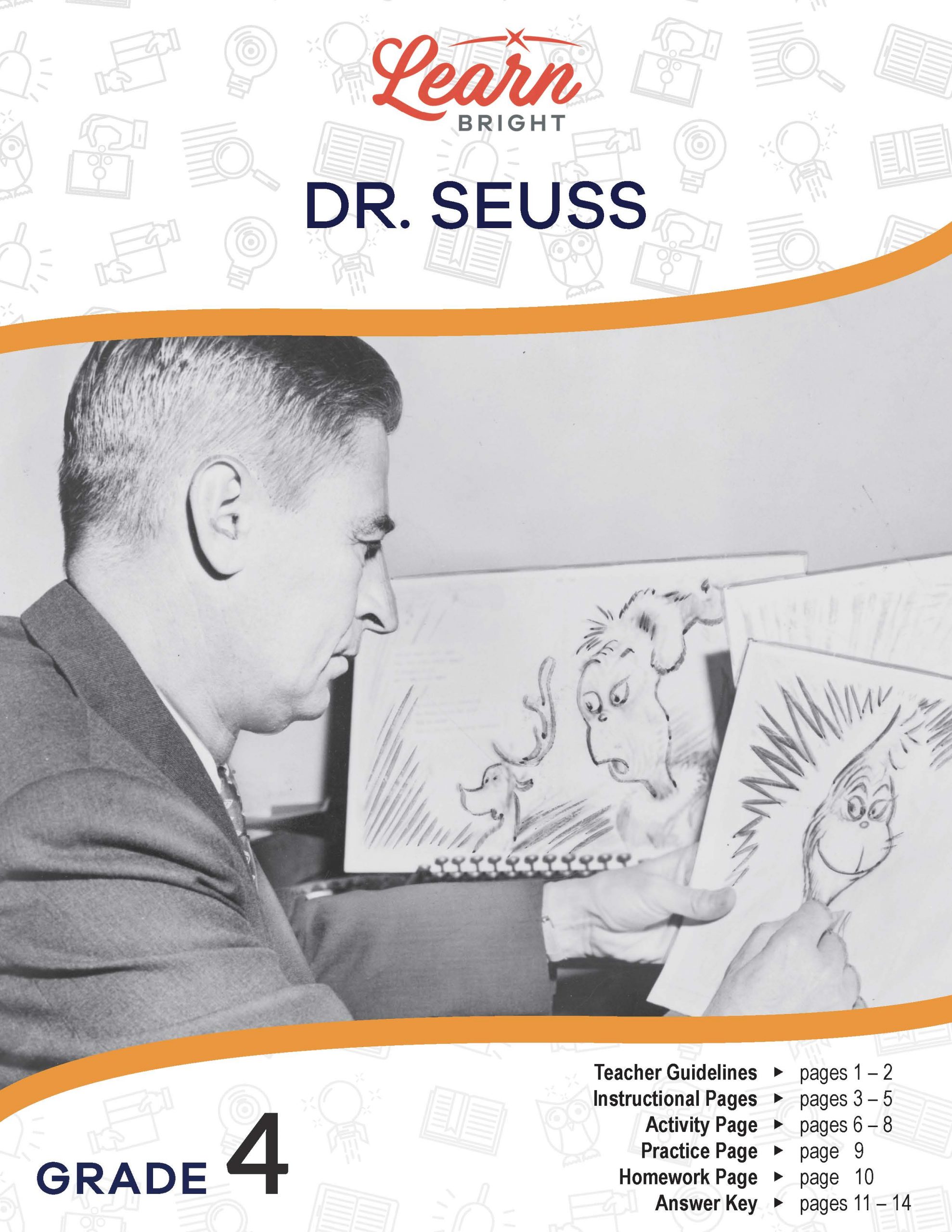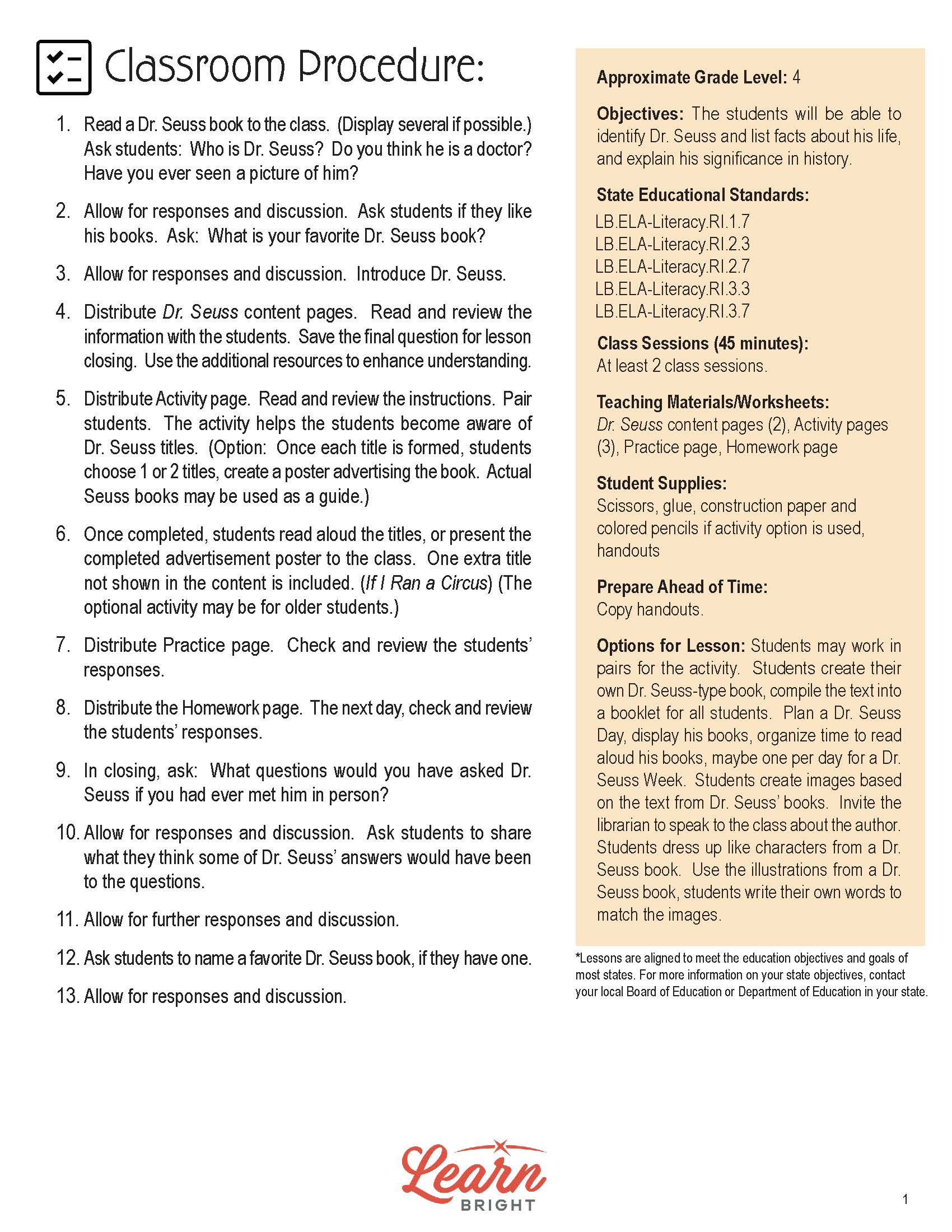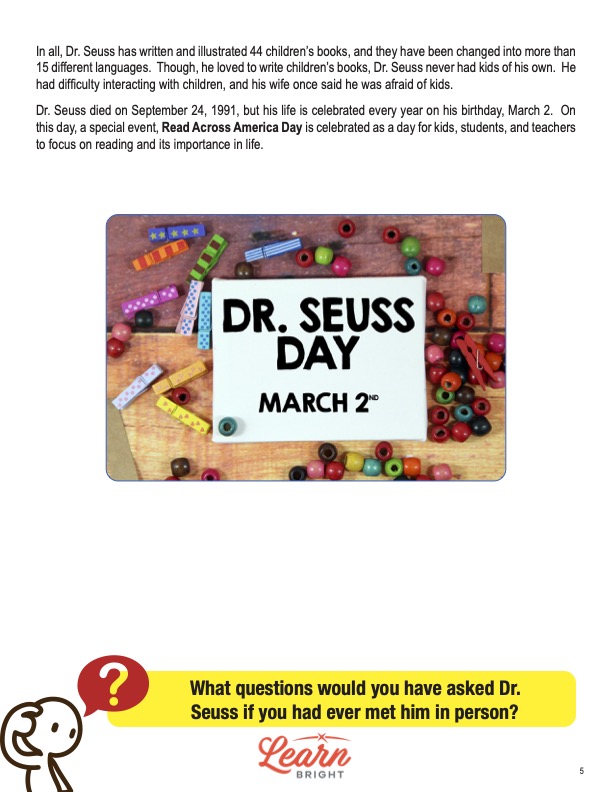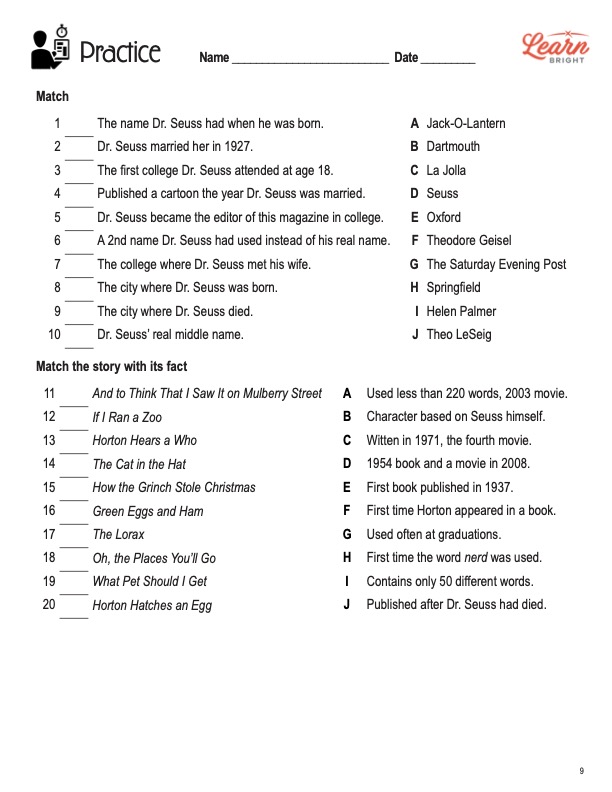Description
What our Dr. Seuss lesson plan includes
Lesson Objectives and Overview: Dr. Seuss teaches students about the life of this famous children’s book author. Students will be able to identify him and list facts about his life. They will also learn about his place in history and why he is important. This lesson is for students in 4th grade.
Classroom Procedure
Every lesson plan provides you with a classroom procedure page that outlines a step-by-step guide to follow. You do not have to follow the guide exactly. The guide helps you organize the lesson and details when to hand out worksheets. It also lists information in the yellow box that you might find useful. You will find the lesson objectives, state standards, and number of class sessions the lesson should take to complete in this area. In addition, it describes the supplies you will need as well as what and how you need to prepare beforehand. For this lesson, you need scissors, glue, construction paper, and colored pencils.
Options for Lesson
The “Options for Lesson” section lists a number of suggestions for activities or ideas to add to the lesson or substitutions for the ones already in the lesson. One idea is to allow students to work in pairs for the activity. As an additional activity, you could have students create their own book in the style of Dr. Seuss. You could also plan a special Dr. Seuss Day during which you display his books and read from them aloud. You could do this for an entire week and read different books every day, dress up as his characters, and so on. Another idea is to have students create images based on his books. One last option is to invite the school librarian to speak to your class about the author’s works.
Teacher Notes
The teacher notes page includes a paragraph with additional guidelines and things to think about as you begin to plan your lesson. It reminds teachers that while almost every student will have heard of Dr. Seuss or read at least one of his books, many students will not know anything about his life or background. It also highly recommends using some online resources to help enhance this lesson. This page includes lines that you can use to add your own notes as you prepare.
DR. SEUSS LESSON PLAN CONTENT PAGES
Doctor or Author?
The Dr. Seuss lesson plan contains three content pages. The first section of this lesson describes the author’s early life and background and explains how he became an author. Students will first learn that Theodore Geisel—Dr. Seuss—is not an actual doctor. Instead, he is a famous author of children’s books like Cat in the Hat and Green Eggs and Ham.
Geisel was born in Massachusetts on March 2, 1904. His mother’s maiden name is Seuss, which became half of the fake name he used when he published his books. A fake name is a pseudonym. While growing up, his father always wanted him to become a doctor. As a result, he added the “Dr.” part to his pseudonym.
Theodore was 18 when he attended Dartmouth College in the state of New Hampshire. He became the editor of a humor magazine called Jack-O-Lantern. However, he was kicked out of the magazine staff at one point but continued writing stories for it under the fake name of Seuss.
Geisel intended to become a professor after graduating from Dartmouth. He attended Oxford College in England where he met his future wife, Helen Palmer. He married her in 1927 and dropped out of Oxford, moving back to the United States. Students will discover that it was during this same year that he first used the Dr. Seuss pseudonym in a cartoon published in The Saturday Evening Post.
Books, Books, and More Books
The next section of the lesson focuses on some of Dr. Seuss’s most famous and important books. The first book Theodore published was rejected 27 different times! But he did not give up and eventually got the book published. After the first book, he created posters and films for the US government that they used during World War II. After the war ended, Dr. Seuss began writing for eight hours a day, making writing children’s books his full-time job. As a hobby, he enjoyed working in the garden at his home when he wanted a break.
Many of the author’s various works are very well known around the world. People use them to help teach children how to read. The stories are fun, creative, and interesting, which keeps their readers engaged. The lesson lists nine of Seuss’s most popular books along with some information about them. Students will learn, for instance, that Dr. Seuss based the Grinch in How the Grinch Stole Christmas on himself.
In total, Dr. Seuss wrote and illustrated 44 children’s books, which have been translated into more than 15 languages. Although he loved to write books for children, Theodore Geisel never had any children of his own. In fact, he had difficulty interacting with kids sometimes and might even have been afraid of them.
March 2 of every year marks the celebration of Read Across America Day. On this day, people celebrate the life and works of this great author. The focus of the celebration is on the importance of reading for students, teachers, and everyone else. The lesson ends by asking students what questions they would have asked Dr. Seuss if they could meet him in person.
DR. SEUSS LESSON PLAN WORKSHEETS
The Dr. Seuss lesson plan includes three worksheets: an activity worksheet, a practice worksheet, and a homework assignment. These worksheets are intended to make sure that students have understood the lesson material. You can refer to the guide on the classroom procedure page to determine when to hand out each worksheet.
CUT AND PASTE ACTIVITY WORKSHEET
Students will work on their own for the activity (they can also work in pairs if you’d like them to). First, they will cut out words and form them into Dr. Seuss book titles. Then, they will glue those titles onto a sheet of paper. Using colored pencils, they will shade each title a different color.
DR. SEUSS PRACTICE WORKSHEET
For the practice worksheet, students will first match facts with names, place names, and important objects from Dr. Seuss’s life, like “Jack-O-Lantern” and “Helen Palmer”. Next, they will match his story titles with facts about those stories. For example, they would match “And to Think That I Saw It on Mulberry Street” with the fact “First book published in 1937”. They can find all of the information they need for this practice worksheet in the content pages of the lesson.
MEANING OF THE QUOTE HOMEWORK ASSIGNMENT
The homework assignment is split into two parts. In the first part, students will work with a parent or other family member to read Dr. Seuss quotes and describe what they think the quotes mean. In the second part, students will write a short rhyming poem that they think the author might have liked.
Worksheet Answer Keys
This lesson plan includes answer keys for the activity worksheet, the practice worksheet, and the homework assignment. The answer key for the homework assignment offers some possible answers to the prompts, but also notes that student’s answers for this assignment will vary. If you choose to administer the lesson pages to your students via PDF, you will need to save a new file that omits these pages. Otherwise, you can simply print out the applicable pages and keep these as reference for yourself when grading assignments.










